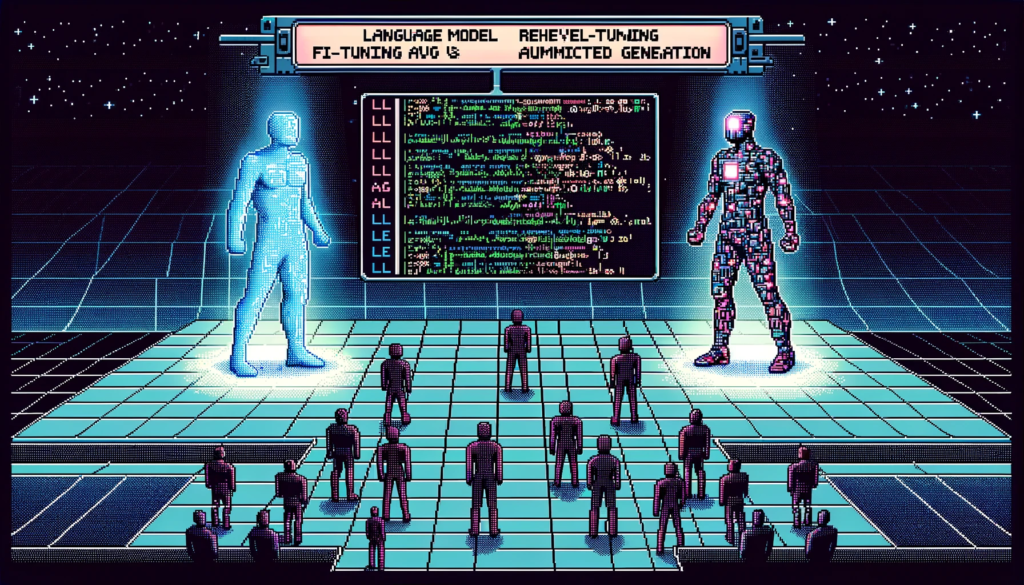When it comes to customizing language models (LLMs) for business needs, the options can be overwhelming. Two popular techniques, fine-tuning and Retrieval-Augmented Generation (RAG), promise to optimize model performance, but which one is right for your business? In this guide, we’ll dive into the world of LLM customization, exploring the benefits and drawbacks of fine-tuning and RAG, and providing a strategic framework for choosing the best approach for your business.
In today’s digital landscape, businesses rely heavily on LLMs to generate content, respond to customer queries, analyze vast amounts of data, make predictions, participate in strategic planning, and much more. However, pre-trained commercial LLMs often fall short of meeting specific business needs. This is where fine-tuning and RAG come into play – two techniques designed to adapt LLMs to your business’s unique requirements.
Fine-tuning involves adjusting a pre-trained LLM’s parameters to better suit a specific task or domain. This approach is ideal for businesses requiring high accuracy and control over the model’s output. Fine-tuning allows for the adaptation of the model’s behavior, writing style, or domain-specific knowledge to specific nuances, tones, or terminologies. However, it can be computationally expensive and require large amounts of domain-specific, labeled training data.
Retrieval-Augmented Generation (RAG), on the other hand, integrates retrieval capability into an LLM’s text generation process, fetching relevant document snippets from a large corpus. This approach excels in dynamic data environments, continuously querying external sources to ensure that the information remains up-to-date without frequent model retraining. RAG is designed to augment LLM capabilities by retrieving relevant information from knowledge sources before generating a response, making it ideal for applications that query databases, documents, or other structured/unstructured data repositories.
So, how do you choose between fine-tuning and RAG? The answer lies in understanding your business needs and the specific requirements of your project. Consider the following key factors:
- Data Readiness: Do you have access to a large, high-quality dataset specific to your domain? If so, fine-tuning might be the better choice. If not, RAG’s ability to retrieve external information could be more beneficial.
- Model Behavior Modification: Do you need to modify the model’s behavior, writing style, or domain-specific knowledge? Fine-tuning excels in this area.
- External Data Access: Do you require access to external data sources, such as databases or documents? RAG is the clear winner here.
- Data Dynamics: Are you dealing with frequently updated or changing data? RAG’s ability to continuously query external sources makes it a better fit.
Understanding Fine-Tuning and RAG: Key Concepts for Business-Specific LLMs
As we explored in the previous section, fine-tuning and Retrieval-Augmented Generation (RAG) are two powerful techniques for customizing language models (LLMs) to meet specific business needs. However, to truly harness the potential of these approaches, it’s essential to understand the key concepts underlying each technique.
Fine-tuning, at its core, is a process of adapting a pre-trained LLM to a particular task or domain. This involves adjusting the model’s parameters to better fit the desired output, much like a tailor altering a suit to fit an individual’s unique measurements. Fine-tuning is particularly useful when you have a large, high-quality dataset specific to your domain, as it allows the model to learn from this data and improve its performance.
One of the primary advantages of fine-tuning is its ability to modify the model’s behavior, writing style, or domain-specific knowledge. By doing so, businesses can create LLMs that are tailored to their specific needs, whether that’s generating content in a particular tone or responding to customer queries with intimate business details. However, fine-tuning can also be computationally expensive, requiring significant resources and specialized expertise.
Retrieval-Augmented Generation (RAG), on the other hand, takes a fundamentally different approach to customizing LLMs. By integrating retrieval capability into the model’s text generation process, RAG enables the model to retrieve relevant data from a vector store, database, or even the internet itself. This approach is particularly useful in dynamic data environments, where the information is constantly changing and updating.
One of the key benefits of RAG is its ability to augment LLM capabilities by retrieving relevant information from knowledge sources before generating a response. This approach is ideal for applications where accessing external data is crucial, such as question answering or information retrieval. Additionally, RAG systems are less prone to hallucination, as they rely on verifiable information from external sources rather than generating responses based on patterns in the data.
In terms of model size, fine-tuning is generally more suitable for smaller models, whereas RAG is often preferred for larger models. This is because smaller models benefit from direct domain-specific knowledge input, which fine-tuning provides. Larger models, on the other hand, can retain their pre-training abilities and leverage external knowledge sources through RAG.
Choosing the Right Approach: Considerations for Data Readiness, Model Behavior, and Industry-Specific Needs

Selecting the right approach between fine-tuning and Retrieval-Augmented Generation (RAG) depends on a variety of factors, including data readiness, model behavior, and industry-specific needs.
Data readiness is a critical factor in determining the suitability of fine-tuning and RAG. Fine-tuning requires large amounts of high-quality, domain-specific data to adapt the model to your business needs. If you have access to such data, fine-tuning can be an effective way to improve model performance. However, if your data is limited or of poor quality, RAG may be a better option, as it can leverage external knowledge sources to compensate for the lack of domain-specific data.
Model behavior is another essential consideration. Fine-tuning is particularly useful when you need to modify the model’s behavior, writing style, or its specific training knowledge to fit your business needs. For instance, if you’re developing a chatbot for customer support, RAG is great for accessing and retrieving company specific details, but fine-tuning can help adapt the model to your brand’s tone and language.
In addition to these factors, businesses must also consider the trade-offs between fine-tuning and RAG. Fine-tuning can be computationally expensive and require a number of resources, whereas RAG may require additional infrastructure to support the retrieval of external data. While both methods are relatively affordable these days (with fine-tuning requiring smaller data sets and vector databases being cheaper to maintain) there are still trade-offs. For one, fine-tuning may require a higher level of technical knowledge to implement, whereas RAG will either require reliance on third-party tools or developers.
When to Fine-Tune: Cost-Effective Solutions for Small Models and Domain-Specific Knowledge
Fine-tuning is a powerful technique for adapting language models to specific business needs, particularly when it comes to small models and domain-specific knowledge. In this section, we’ll explore the scenarios where fine-tuning is the preferred approach, including cost-effective solutions for small models and domain-specific knowledge.
One of the primary advantages of fine-tuning is its ability to improve the performance of small models. By adapting the model to your specific business needs, fine-tuning can help small models achieve comparable performance to their larger counterparts, but at a fraction of the cost. This is particularly useful for businesses with limited resources, where the cost of training and deploying a large model may be prohibitively expensive.
Fine-tuning is also an effective way to adapt language models to domain-specific knowledge. By training the model on a specific dataset or task, fine-tuning can help the model learn the nuances and subtleties of that domain. This is particularly useful for industries where domain-specific knowledge is paramount, such as healthcare, finance, or law.
Another key benefit of fine-tuning is its ability to improve the interpretability of language models. By adapting the model to a specific task or domain, fine-tuning can provide insights into how the model is making predictions, allowing businesses to identify areas for improvement and optimize their models for better performance.
In addition to these advantages, fine-tuning can also be used to create cost-effective solutions for small models. By using transfer learning, businesses can leverage pre-trained models and fine-tune them for their specific needs, eliminating the need for costly model training from scratch. This approach can be particularly useful for small businesses or startups with limited resources.
Fine-tuning can also be used to improve the efficiency of language models. By adapting the model to a specific task or domain, fine-tuning can reduce the computational resources required for inference, making it more efficient and cost-effective. This is particularly useful for businesses where model deployment is a critical consideration, such as in cloud-based or edge computing scenarios.
When to RAG: Leveraging Vector Databases and Third-Party Options for Efficient External Knowledge Integration
Retrieval-Augmented Generation (RAG) is a powerful technique for integrating external knowledge into language models, particularly when it comes to leveraging vector databases. In this section, we’ll explore the scenarios where RAG is the preferred approach, including the benefits of leveraging vector databases and third-party options for efficient external knowledge integration.
One of the primary advantages of RAG is its ability to leverage vector databases for efficient external knowledge integration. By using vector databases, businesses can store and query large amounts of data in a compact and efficient manner, allowing for faster and more accurate retrieval of relevant information. This is particularly useful for applications where speed and accuracy are critical, such as in question answering or information retrieval.
While RAG is also relatively simple to develop, many third-party services offer affordable RAG systems, so you don’t have to develop your own solution. By leveraging third-party APIs and services, businesses can tap into vast amounts of external data and knowledge, without having to store and manage it themselves. This approach can be particularly useful for businesses where data storage and management are a significant concern, such as in cloud-based or edge computing scenarios.
RAG can also be used to create more personalized and engaging user experiences. By integrating external knowledge and adapting to user needs, RAG can help businesses create more targeted and relevant responses, improving user satisfaction and loyalty.
Finally, RAG can be used to improve the scalability and efficiency of language models. By leveraging external knowledge and reducing the need for model training and deployment, RAG can help businesses scale their language models more efficiently, while reducing costs and improving performance.
Maximizing LLM Performance: Strategic Integration of Fine-Tuning and RAG for Optimal Business Outcomes

In the previous sections, we explored the benefits and trade-offs of fine-tuning and Retrieval-Augmented Generation (RAG) for Large Language Models (LLMs). We saw how fine-tuning can be used to adapt LLMs to specific business needs, improve model performance, and reduce costs. We also saw how RAG can be used to integrate external knowledge into LLMs, improve model flexibility and adaptability, and enhance user experiences.
However, the question remains: how can businesses strategically integrate fine-tuning and RAG to maximize LLM performance and achieve optimal business outcomes? The answer lies in understanding the strengths and weaknesses of each approach and combining them in a way that leverages their respective benefits.
One approach is to use a hybrid model that combines fine-tuning and RAG. For example, a business can fine-tune an LLM on a specific task and then use RAG to integrate external knowledge into the model. This approach can help improve model performance, while also providing the benefits of external knowledge integration.
(NOTE: Now, GPT3.5 is available to fine-tune AND it is accessible through GPT Assistants. This means you can easily fine-tune and connect a RAG database using OpenAI).
Ultimately, the key to maximizing LLM performance is to understand the strengths and weaknesses of each approach and combine them in a way that leverages their respective benefits. By strategically integrating fine-tuning and RAG, businesses can create powerful LLMs that drive real results and improve their bottom line.

